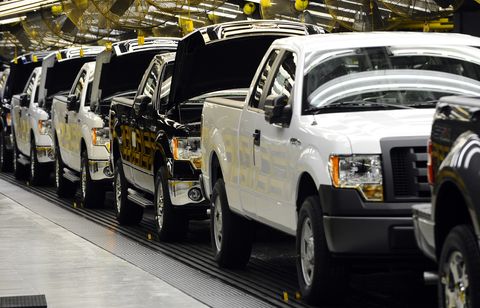
Larry W. SmithGetty Images
Ford announced today that it is partnering with 3M in order to manufacture powered air-purifying respirators (PAPRs) as part of its response to the COVID-19 pandemic. These respirators are often called positive-pressure masks as they take contaminated air, pull it through a filter, then push it to the sealed mask using an air blower.
Ford will assist by providing components from their parts bin to build the respirators. The design released by Ford (top) will use 3M filters that draw air into a blower motor sourced from an F-150 and then pushed through a tube up to a mask that is sealed to the user’s face.
The blower motor is sourced from the F-150’s front seat assembly and is usually employed as part of the ventilated seat option. These motors are compact and run on 12 volts in the car, so they can be used with a battery pack in a situation where they need to be portable.
Seat blower motors may not seem like the first choice, but they are actually matched quite well to the blowers that are usually present in these types of respirators. According to Delta Group, seat blowers can operate at 9 to 16 volts while drawing around half an amp. This allows them to produce between 14 and 19 cfm of airflow.
In comparison, the motor inside the 3M TR-800 system produces between 6.7 and 7.8 cfm depending on the setting, making the seat blower a very close match. The seat blower’s power can be adjusted via a variety of methods–like PWM control–in order to bring it down to the same level of airflow as the purpose-built respirator blowers.
This air flow rating is also partly why blower motors used for the primary HVAC systems in cars would not be a good choice. These units can produce hundreds of cfm of airflow. Size is also a factor. Seat blowers are usually around 3×3 or 4×4 inches wide and less than an inch tall. A primary HVAC blower motor is often 6×6 inches wide and over six inches tall.
Ford is planning to use power tool batteries to operate the respirators. Based on their sketches, it looks like they will use something similar to the Dewalt DC9071 12-volt. This battery is rated at 2.4 amp hours, which allows us to get an estimate of run time using the Time = Current/Amps formula. In this case we would take the 2.4 amp hours and divide it by 0.5 amps from the blower rating above to give us a rough run time of a little under five hours.
Since these blowers would only need to run at half speed, it is possible that the run time could be doubled, extending it all the way up to 10 hours. These numbers would be comparable to the purpose-built respirator battery packs which range from four to six hours for standard units and eight to 12 hours for high capacity units.
The great thing about using off-the-shelf parts is that most of the pieces needed to assemble these respirators are available in fairly large quantities. The seat blower motors can be pulled off the shelf by Ford and they can request more from their suppliers if needed. The drill battery packs use a standard interface and are available from the original equipment manufacturers as well as many aftermarket sources.
Ventilated seats are fairly widespread now, with many manufacturers sourcing the blowers from the same suppliers. One of the biggest is Gentherm. They’ve supplied parts for many Ford vehicles in the past and build blowers for a variety of manufacturers. Cars like the Jeep Grand Cherokee use Gentherm blowers that are very similar in design to those used on the F-150, so other automotive manufacturers could also potentially join Ford by either providing manufacturing capability or supplying some of the parts that they have on their shelves.
Masks will likely require some work, but Ford has already started employing their resources at their Advanced Manufacturing Center in Redford, Michigan to produce face shields employing things like their in-house 3D printers to build certain components. It is likely that they can transfer some of those capabilities in order to build respirator masks.
Ford has already started delivering face shields, and we look forward to hearing more progress on the respirator front as they work with 3M to complete the design and ramp up production.

